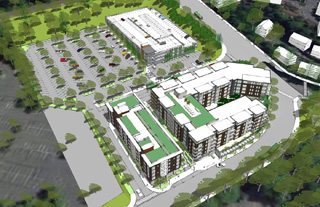|
Subscribe / Renew |
|
|
Contact Us |
|
| ► Subscribe to our Free Weekly Newsletter | |
| home | Welcome, sign in or click here to subscribe. | login |
Environment
| |
 |
February 23, 2012
Which green certification program is right for you?
Weber Thompson

Benotto
|
Green building practices are rapidly becoming the standard. The new challenge isn’t choosing to go green — it is deciding which shade is deep enough for your project and by which standard to measure it.
We discovered, for example, there were at least six green certification programs that could apply to a large, mixed-use transit-oriented development in South Kirkland we are designing. We could easily expand the list to more than a dozen certification programs, all directly related to the building, site program and green goals.
If that abundance could perplex a room of sustainability-savvy architects, what would our clients and stakeholders be feeling? Confused and overwhelmed, most likely.
The easiest path is to start with programs tied to incentives such as increased height or expedited permitting. Locally, that generally means three programs: LEED, Built Green and the Evergreen Sustainable Development Standard.
LEED
LEED is the most commonly known, accepted and used standard.
Developed by the U.S. Green Building Council, its criteria are continually updated and made more rigorous. There are nine different LEED rating systems: eight based on building type and one for neighborhood development. Just about the only building type that doesn’t qualify is a standalone parking structure, one of the components of our TOD project.
Despite LEED’s complexity and increasing competition from other programs, there are currently almost 9 billion square feet of building space participating in its suite of rating systems. LEED is likely to remain the foremost contender.
Built Green
While much of the criteria in LEED leaves the methods for achieving the end result up to the designers, you have to admire Built Green for getting right to the point.
Developed by the Master Builders Association of King and Snohomish Counties, Built Green’s prescriptive approach showcases its builder roots. Accessible and specific, it has credit-point scoring than can go over 500 points.
In water efficiency, for example, separate points are allocated for efficient bathroom faucets, kitchen faucets and shower heads, and so on. That saves time on calculations over a baseline case, as in LEED.
Like LEED, Built Green has its critics. It has been called too easy, which is true at the three-star level or lower, but the four- and five-star levels are on par with LEED.
Depending on the criteria selected, Built Green can drive buildings that would achieve LEED silver or gold, and can sometimes exceed LEED. For example, one of the energy prerequisites at the four-star level requires a minimum 15 percent improvement over the current Washington State Energy Code; LEED’s energy prerequisite is an estimated 6 to 10 percent improvement.
Built Green’s five-star system was developed in conjunction with Salmon Safe, with site requirements exceeding those of LEED and National Pollutant Discharge Elimination System permitting.
Evergreen standard
The Evergreen Sustainable Development Standard is required by Washington state for all projects receiving housing trust funds.
Like LEED and Built Green’s four- and five-star levels, ESDS is third-party verified. While it shares similarities with LEED, it is more akin to Built Green. The program has “79 criteria that safeguard health and safety, increase durability, promote sustainable living, preserve the environment, and increase energy efficiency,” according to the state Department of Commerce website.
True to its mission of providing for the well-being of residents, it requires the use of low or no off-gassing building materials (optional in LEED) and criteria for access to fresh and local foods.
On our TOD, both affordable and market-rate housing will be built over a common podium and parking garage. The ESDS can apply to both types of projects when they are part of the same development.
County scorecard
What about certifying a standalone parking structure? That’s not a possibility with LEED, Built Green or ESDS, but there was one local program that could be used: the King County Sustainable Infrastructure Scorecard.
Developed by King County’s Green Tools Team, it adapts basic concepts of LEED to infrastructure capital projects, specifically when there is less than 5,000 square feet of conditioned indoor space.
Since King County is the landowner and major stakeholder of the transit center and parking structure ... Bingo! Perfect match.
The KCSIS program has a few interesting distinctions from LEED. It requires a life-cycle cost assessment, which is only a pilot credit in LEED, and an accounting and mitigation of greenhouse gas emissions.
Other programs
We came up with other major programs that could also be considered:
2030 Challenge: A program developed to decrease greenhouse gas emissions so buildings are carbon neutral by 2030. The program’s targets are phased so they get continually more stringent over time.
Current requirements are for a 60 percent reduction below the national average for a given building type. This is not a comprehensive green building certification program and could be a supplement to another program that didn’t include greenhouse gas emission-targeted reductions.
Living Building Challenge: The ultimate in current certification programs — no credits, and all prerequisites to achieving net-zero energy use, net-zero water use, zero net carbon and other stringent criteria.
ICC 700 National Green Building Standard: The International Code Council, or ICC, is the only program with approval from the American National Standards Institute. This web-based scoring tool defines standards for all types of residential construction and remodeling, with third-party certification by the National Association of Home Builders Research Center.
While it applies to all types of residential projects, it focuses on single-family homes. Though more than 2,000 projects are certified nationally, we couldn’t find one in Washington.
Green Globes: Green Globes, an import from Canada and England, is considered by some jurisdictions in the U.S. to be equivalent to LEED; in others it’s considered an affordable alternative.
There are only four projects with Green Globe certification in Washington. It is generally dismissed here because it has received support from the timber and vinyl industries. (LEED is also supported by the vinyl industry.) Its lack of local support prevented us from pursuing this as an option for the TOD.
Others: More specialized certification programs include Sustainable Sites Initiative, Salmon Safe, Certified Wildlife Habitat and Energy Star, among many others.
What we chose
In the end, our team decided to use the ESDS for the affordable apartments, Built Green four-star for the market-rate apartments and KCSIS for the standalone parking structure.
Despite multiple certifications for this project, our team decided to focus on our common goals of energy, water and material efficiency, and a healthy indoor and outdoor environment.
Our most important goal, however, was to create a great place where people will want to take transit. After all, no matter how you measure it, taking transit, walking or biking will have the biggest impact on our environment, and we shouldn’t let the building certification program get in the way of that achievement.
Catherine Benotto is a principal of landscape architecture and community/urban design at Weber Thompson.
Other Stories:
- Does a green retrofit make sense for your building?
- LEED platinum house: green from start to finish
- Your projects can still be green, even if LEED doesn't fit
- City expands its goals for green with 2030 District
- 'Living buildings': What we’ve learned so far
- How we earned LEED platinum without blowing our budget
- ‘Living streets’ aren’t just for drivers
- Putting power-hungry data centers on a diet
- Workers prefer their office makeovers green
- Live, work and farm at Ballard's Greenfire



